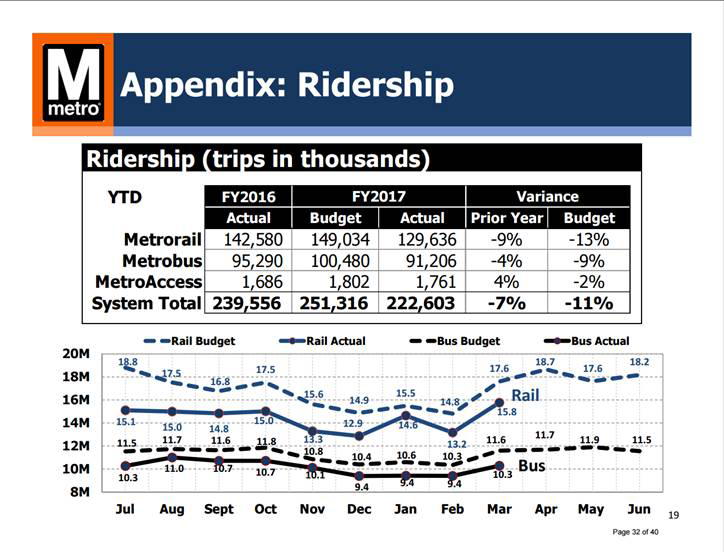WASHINGTON — Metro ridership continues to decline across all times of day and days of the week, according to documents to be presented Thursday to the Metro Board of Directors.
Average weekday rail ridership is down 9 percent, or 12.9 million trips, in the first three months of the year compared to the same period in 2016.
That decline has dragged down bus ridership too, since Metro attributes about 75 percent of the 4 percent decline in bus ridership this quarter to the departure of riders who used the bus to transfer to or from the rail system. Those riders had made up about a quarter of all bus trips.
For the period from July through March, combined rail and bus ridership is down 7 percent compared to a year earlier, which is 11 percent lower than Metro’s budget had projected.
Metro now forecasts a $38 million operating deficit for the year ending June 30. About $18 million is expected to be covered by a surplus from last year’s budget and $20 million is expected to be shifted to Metro’s capital construction budget.
Metro documents blame the current 1 percent deficit on declining revenues, “primarily due to falling ridership caused by SafeTrack, reliability challenges and market factors.”
Rail fare revenue is down 11 percent from the previous year, even though the transit agency had forecast an increase. Parking revenue is down 9 percent from the previous year. Bus fare revenue is down 10 percent over the previous year. Metro is launching a renewed effort to crack down on fare evasion to ensure all people who do still ride pay to do so.

“Service disruptions due to the SafeTrack program have affected rail and bus ridership in many corridors, and overall ridership continues to face service reliability challenges as well as the impact of alternative transportation options, low gasoline prices, and telecommuting. Revenues are below budget by $87 million year to date,” the board documents stated.
The round-the-clock work zones have helped Metro cut costs too, though, and Metro does not expect any additional local tax dollars will be needed before June 30. By scheduling fewer trains across the system during work zones, Metro has lowered costs ranging from the workers who operate the trains to the power that propels them.
“Propulsion expenses were below budget by $2.8 million or 7.4 percent. This favorable volume utilization is mainly driven by lower service levels during SafeTrack,” the documents stated.
Metro is due to cut scheduled rush-hour service and change the rail system’s operating hours starting July 1.
The ridership numbers would look even worse were it not for the Women’s March this year and the complete shutdowns of the system last January following a major blizzard and last March following significant cable fires.
“Rail and bus ridership increased 14 percent over the prior year in January. However, the declines experienced in the first half of the fiscal year returned in February and March,” the documents stated.
The January bump contributed to the January-to-March ridership decline coming in at 9 percent compared to the same time a year earlier, slightly better than the 12 percent year-to-year decline Metro saw in the October-to-December time frame when there were more days with significant 24/7 work zones in place.
With the topsy-turvy weather in March changing cherry blossom bloom expectations, Metro said it did not see its traditional bump in ridership for the Cherry Blossom Festival this year.
Rider declines are particularly noticeable in evenings, the Metro documents said, when track work regularly extends the scheduled waits between trains.
Rider satisfaction remains relatively flat at 69 percent for rail riders and 74 percent for bus riders.
MetroAccess paratransit trips did not grow as quickly as Metro had projected, rising 4 percent over the previous year. MetroAccess revenue rose 8 percent over the same time a year earlier, just slightly below budget.







